TRUE BUDDHA SCHOOL TIMELINE
1945: Lu Shengyen was born in Jiayi, Taiwan.
1969: Shengyen reported receiving extraordinary visions of Bodhisattvas and a spiritual awakening at the Temple of the Jade Emperor. He had a vision of his previous incarnation, the white Lotus Youth, in a dream at home. There were continued visits by invisible spiritual teachers at night.
1969: Shengyen started a small home temple for divination, geomancy consultation and performance of rituals for the dead and penance rituals.
1972: Shengyen took refuge in Buddhism and received the precepts of Bodhisattvas at the Bishanyan temple in Nantou in Taizhong, Taiwan. He became a Daoist at the Shibi branch of the Cihui Tang Daoist temple in Hualian, Taiwan.
1969- 1975: Shengyen underwent a period of spiritual education and development, mainly under the Daoist recluse Qingzhen on Mt. Liantou at Nantou.
1975: Shengyen published three nonfiction books; he wrote newspaper columns on his encounters with world of spirits.
1976: Shengyen encountered His Holiness the Sixteenth Karmapa, head of the Karma Kagyu (white) school of Tibetan Buddhism, during the Karmapa’s first visit to Taiwan.
1977: Shengyen completed his decade of service with the Army and began to allow non-Taiwanese to take refuge in him.
1981: Shengyen moved to the United States (Seattle). He was formally initiated by and received more advanced empowerment from the Karmapa and received secret high tantric teachings from H.E. Dezhung Rinpoche of the Sakya (Flower) school of Tibetan Buddhism.
1983: Shengyen announced his enlightenment experience, calling it “achieving luminosity.”
1984: Shengyen renamed his school the “True Buddha School of Spirits and Immortals” (later simplified to “True Buddha School”).
1987 (March 7): Shengyen began lecturing on the Amitābha sutra (Sukhāvatī-vyūha), a series of sixty-two lectures that ended on June 12, 1988.
1989: Shengyen began a four-year worldwide proselytizing campaign, with one large international Dharma ceremony at a different location each year.
1991: Shengyen began a one-year broadcast on North American satellite television to give an account of his enlightenment experience and lectures on Heart Sūtra (Prajñāpāramitāhṛdaya).
1993: Shengyen toured Europe, set up a Central Committee for the school’s affairs, and maintained a letter-replying centre in Seattle. He made the first of a series of retirement announcements that were soon followed by a resumption of writing and lecturing (1993, 1994, 1995, 2000, 2006, 2008, 2013, 2016, 2021, 2022).
1994: The True Buddha News Weekly, a newspaper serving the movement internationally, was founded. It was followed by the Enlightenment Magazine in late 1990s.
1996: Vancouver’s Lotus Light Temple (Huaguang), became the home base of the True Buddha News Weekly and the Lotus Light Charity Society, the movement’s primary charitable organization.
1997: The True Buddha Foundation was organized to support charity work carried out by the Lotus Light Charity Society.
1997 (June): Rev. (unnamed individual #1), Finance Director of the True Buddha Foundation, Chairman of the Huaguang Merit Society in California, and Abbot of the Weiguang temple at Los Angeles was dismissed from his positions.
2016 (September): Rev. (Unnamed individual #2) of the Purple Lotus Temple at Fremont, California was dismissed from her position.
2016 (October 3): “Demon soldiers,” were said to have been sent by Rev. (unnamed individual #2) to Shengyen’s home at night but were defeated by his spiritual protectors.
2017: Seventeen monks and nuns belonging to the Purple Lotus Temple were excommunicated by the True Buddha Foundation.
FOUNDER/ GROUP HISTORY
The True Buddha School belongs to an esoteric form of Buddhism known as the Diamond Vehicle or Vajrayāna. It is also called Tantric Buddhism, but as this form of Buddhism is popular in Tibet, most people simply call it a “Tibetan” form of Buddhism. The school was started in 1973 in Taiwan, and its following has permeated the Chinese diaspora community throughout southeast Asia and the West. In 1984, the school calculated its membership as 40,000, but by 1996, it reportedly had increased one hundred times and numbered over 4,000,000. In 2013, the reported membership of the school reached
5,000,000. Worldwide, there are now over 300 chapters and about sixty temples. There is a rumour 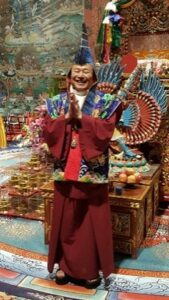 circulating within the school that the founder of the school may leave this world once the membership exceeds 5,000,000; therefore, the school ceased calculating its membership after it reached 5,000,000.
circulating within the school that the founder of the school may leave this world once the membership exceeds 5,000,000; therefore, the school ceased calculating its membership after it reached 5,000,000.
The founder of the True Buddha School, Lu Shengyen, [Image at right] was born in Jiayi, southwest Taiwan in 1945. He grew up as a Christian and belonged to the Presbyterian church, but he had a deep religious experience in 1969 that led him from his Christian upbringing into a period of seeking, study, and learning. During that period, he became a Buddhist and began to teach Buddhism. Near the end of this period, he founded the True Buddha School and moved to the United States, a symbol of his intention to spread Buddhism internationally.
According to the hagiographic account of Shengyen’s, religious conversion is fascinating. One day in 1969, he and his mother visited a temple in Taizhong called the Palace of the Jade Emperor. A female medium called Qiandai suddenly called out his name and told him that the gods in the temple wanted him to kneel before them. Notwithstanding his surprise at a stranger’s calling him by name, he did what he was told to do and became “possessed.” In other words, he was suddenly giv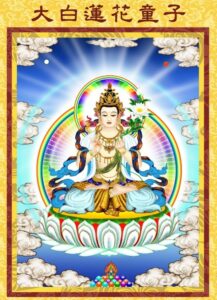 en, without his consent, the ability to see and communicate with the spiritual world. After returning home, he also had a vision of his previous incarnation, the white Lotus Youth, an identity that became clear to him only in later years. Lu later referred to an infant standing on a lotus (a character often portrayed in the Dunhuang Mogao Buddhist caves, also known as the Thousand Buddha Grottoes in Gansu) as his previous incarnation. Shengyen claims that the “white Lotus Youth” is his Dharma-body (as opposed to his physical body). [Image at right]
en, without his consent, the ability to see and communicate with the spiritual world. After returning home, he also had a vision of his previous incarnation, the white Lotus Youth, an identity that became clear to him only in later years. Lu later referred to an infant standing on a lotus (a character often portrayed in the Dunhuang Mogao Buddhist caves, also known as the Thousand Buddha Grottoes in Gansu) as his previous incarnation. Shengyen claims that the “white Lotus Youth” is his Dharma-body (as opposed to his physical body). [Image at right]
After the miraculous encounter in 1969, Shengyen continued to receive the nocturnal visits of an invisible spiritual teacher who taught him Daoist ritual dances, different spells, and hand gestures to be used in ritual performance. Under the direction of this teacher, he sought out a highly accomplished Daoist master, Qingzhen (d. 1971), on Mount Liantou in Nantou of Taizhong to teach him different Daoist practices, such as the writing of magical charms, spells, alchemy, geomancy, and 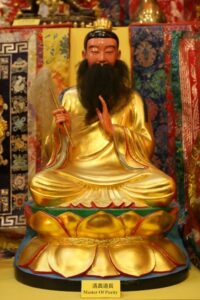 divination. Qingzhen was in his eighties and was a former Buddhist monk by the name of Liaoming (later identified as a disciple of Nuona Hutuketu [1856-1936], of the Nyingma [Red] School of Tibetan form of Buddhism), who became a recluse to practice Daoism on Mount Liantou. The dual identity of Qingzhen is not as surprising. [Image at right] Scholars now understand the frequent crossover and interaction between Daoism and Tantric Buddhism in their rituals, and between Daoist inner alchemy and Tantric Buddhist inner cultivation (Teiser and Franciscus 2011:9). Shengyen continued to learn from Master Qingzhen for two years on his days off from military service as an Army Surveying Officer, until the death of his master. In short, Shengyen equipped himself with all the techniques of a traditional Chinese religious master, from communicating with the spiritual world to charm writing and divination. What remained was to attract followers.
divination. Qingzhen was in his eighties and was a former Buddhist monk by the name of Liaoming (later identified as a disciple of Nuona Hutuketu [1856-1936], of the Nyingma [Red] School of Tibetan form of Buddhism), who became a recluse to practice Daoism on Mount Liantou. The dual identity of Qingzhen is not as surprising. [Image at right] Scholars now understand the frequent crossover and interaction between Daoism and Tantric Buddhism in their rituals, and between Daoist inner alchemy and Tantric Buddhist inner cultivation (Teiser and Franciscus 2011:9). Shengyen continued to learn from Master Qingzhen for two years on his days off from military service as an Army Surveying Officer, until the death of his master. In short, Shengyen equipped himself with all the techniques of a traditional Chinese religious master, from communicating with the spiritual world to charm writing and divination. What remained was to attract followers.
Shengyen first became known to the public as a famous diviner, and from 1969 to 1975, he claimed that every day about two hundred people came to him for divination. In 1975, he published three nonfiction books and began writing columns in the newspaper, telling fascinating stories about his divination and his encounter with the world of spirits. His books have been best sellers and made him even more famous. Since then, Shengyen has been the most prolific writer in Taiwan. He was extremely successful in attracting followers by writing extensively on his own religious experience and inner cultivation. He has produced, on average, six books per year since 1975, and his writings, which his disciples publish in a series, now number over 300 volumes. He has continued to write daily.
Shengyen claims to receive five hundred letters each month from his readers and more than a thousand requests for appointments to see him. Letter-writing remains one of the main ways for him to keep in touch with his disciples around the world. In 1976, he took a three-year retreat from the rush of followers seeking him for divination services and spiritual counselling. It was at this time that he first met the Sixteenth Karmapa, head of the Karma Kagyu (White) school of Tibetan Buddhism, during Karmapa’s first visit to Taiwan. This was Shengyen’s second contact with the Tibetan form of Buddhism, after his study under the Nyingma master Qingzhen/Liaoming, which convinced him to move closer to tantric Buddhism. Divination was not Shengyen’s primary career. He had received his tertiary education in a military college in Taiwan and was trained as an Army Surveying Officer.
The period of Shengyen’s extraordinary experience (1969-1975) was the time when Jiang Jingguo (1910-1988) assumed political leadership of Taiwan. Jiang eventually became president in 1978, succeeding his father Jiang Jieshi (1887-1975), a powerful nationalist military commander in the Kuomintang (the Chinese Nationalist Party in Taiwan). In 1971, Taiwan was forced out of the United Nations, and Taiwan’s diplomatic relations with important nations like Japan and United States were unilaterally ended. At the same time, the economy of Taiwan grew rapidly. It was in these times of great changes and uncertainty that people in Taiwan were attracted to spiritual writings and teachings like those of the True Buddha School.
In addition to writing letters and providing divination services, Shengyen also started a small home temple in 1969 in the city of Taizhong. Beginning in 1969, people went to his temple for divination, geomancy consultation, and the performance of baidou (a star-worship penance ritual) and the chaodu (soul deliverance) ritual for the dead, which became one of the most important rituals of the True Buddha School. In 1972, Shengyen received the (Buddhist) Bodhisattva precepts at the Bishanyan temple in Nantou County of Taizhong. Because of the fame of his remarkable divination skills, Shengyen had to move to a bigger house in 1973. His second home temple had space for forty small statues, and he 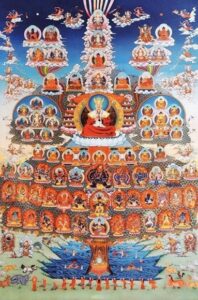 registered as a group member of the Chinese Daoist Association. He named his home temple Cihui Leizang Si, combining the name of the Daoist temple, Cihui, and the term for Buddhist temple, si. Among the statues at his temple were the deities of the (Daoist) Golden Mother of the Primordial Pond, Sakyamuni Buddha, and the Buddhist Bodhisattva Kitigarbha (Dizang, in Chinese). [Image at right] From the beginning, the True Buddha School was a mixture of Buddhism and Daoism. Leizang Si (literally womb/storehouse of thunder) later became the standard name of all the school’s temples.
registered as a group member of the Chinese Daoist Association. He named his home temple Cihui Leizang Si, combining the name of the Daoist temple, Cihui, and the term for Buddhist temple, si. Among the statues at his temple were the deities of the (Daoist) Golden Mother of the Primordial Pond, Sakyamuni Buddha, and the Buddhist Bodhisattva Kitigarbha (Dizang, in Chinese). [Image at right] From the beginning, the True Buddha School was a mixture of Buddhism and Daoism. Leizang Si (literally womb/storehouse of thunder) later became the standard name of all the school’s temples.
From Shengyen’s home temple, branch temples/chapters (Fentang in Chinese) soon developed, first in Taiwan (in a manner like that of the Cihui temple) and then beyond the Cihui model in the main cities of the entire world. In 1977, Shengyen completed his decade of service with the Army and began to allow non-Taiwanese to formally take refuge in him.
In 1981, with the help from early followers in Taiwan, Shengyen moved to Seattle to look for a quiet place to continue his spiritual growth. Chapters of the new school quickly emerged across Canada and the United States, as well as across Southeast Asia. In the same year, Shengyen was formally initiated by and received more advanced empowerment from the Sixteenth Karmapa (1924-1981), the head of the Karma Kagyu (White) School of Tibetan Buddhism, during Karmapa’s last tour to the West. Shortly before the Karmapa’s death, Shengyen received the Five Buddha Empowerment, conferred as an entry point to the practice of Mahayoga, from the Karmapa. Shengyen also received secret high tantric teachings from H.E. Dezhung Rinpoche of the Sakya (Flower) school of Tibetan Buddhism, who happened to be in Seattle during 1982-1985. In 1984, Shengyen made his first trip to Hong Kong and sought out a Chinese teacher, Thubten Dorge (Li Ting Guang), of the Gelug (Yellow) school of Tibetan Buddhism, whose temple is located on Mt. Furong in Tsuen Wan, Hong Kong. By this time, Shengyen had already received religious empowerment from the four major schools of Tibetan Buddhism: Yellow, White, Red and Flower. He also renamed his school, from the Spiritual Immortal (Ling Xian) School to the True Buddha School of Spirits and Immortals (later simplified to the True Buddha School). The name change was occasioned by an unauthorized use (by some of Shengyen ‘s own disciples) of the school’s name to publish a magazine. They had also used the name to collect money from other believers without Shengyen’s consent. Shengyen, therefore, renamed his school to distance it from this incident. The first chapter of his school in Hong Kong, Malaysia, Jakarta, and Sulawesi (aka Celebes), Indonesia were formed in 1984. Many of Shengyen’s disciples subsequently came from Malaysia and Indonesia.
In 1985, Shengyen set up two biannual conventions for the school: (1) the celebration of the Chinese New Year (usually late January or early February, in the second week following the Chinese New Year) at the Taiwan Lei Tsang Temple in Nantou of Taizhong; (2) the Fall Bardo Soul Deliverance Ceremony for the dead (in August or September, in the last week of the seventh month of the lunar calendar) at the Ling Shen Ching Tze Temple in Redmond, Washington (in the Seattle area).
In 1989, Shengyen returned to Taiwan for a visit after living in Seattle for seven years. It later became an established practice that he would leave Seattle to stay in Taiwan for half a year, until the Chinese New Year convention, when he would return to Seattle. In Seattle, every Saturday night, Shengyen would preside over a cultivation session at the Ling Shen Ching Tze temple, preaching and lecturing on a chosen scripture at the end of the session. On Sunday afternoon, he would preside over a fire ritual at the Rainbow Villa Temple in North Bend (also near Seattle), with similar preaching and lecturing. During his half-year stay in Taiwan, he would preside over a ritual at the Taiwan Lei Tsang Temple in Nantou of Taizhong, with a lecture on a chosen scripture, every Saturday afternoon. The Seattle temple and the Taizhong temple became the two headquarters of the school.
From Shengyen’s home temple, branch temples/chapters (Fentang in Chinese) soon developed, first in Taiwan (in a manner like that of the Cihui temple) and then beyond the Cihui model in the main cities of the entire world. In 1977, Shengyen completed his decade of service with the Army and began to allow non-Taiwanese to formally take refuge in him.
In 1981, with the help from early followers in Taiwan, Shengyen moved to Seattle to look for a quiet place to continue his spiritual growth. Chapters of the new school quickly emerged across Canada and the United States, as well as across Southeast Asia. In the same year, Shengyen was formally initiated by and received more advanced empowerment from the Sixteenth Karmapa (1924-1981), the head of the Karma Kagyu (White) School of Tibetan Buddhism, during Karmapa’s last tour to the West. Shortly before the Karmapa’s death, Shengyen received the Five Buddha Empowerment, conferred as an entry point to the practice of Mahayoga, from the Karmapa. Shengyen also received secret high tantric teachings from H.E. Dezhung Rinpoche of the Sakya (Flower) school of Tibetan Buddhism, who happened to be in Seattle during 1982-1985. In 1984, Shengyen made his first trip to Hong Kong and sought out a Chinese teacher, Thubten Dorge (Li Ting Guang), of the Gelug (Yellow) school of Tibetan Buddhism, whose temple is located on Mt. Furong in Tsuen Wan, Hong Kong. By this time, Shengyen had already received religious empowerment from the four major schools of Tibetan Buddhism: Yellow, White, Red and Flower. He also renamed his school, from the Spiritual Immortal (Ling Xian) School to the True Buddha School of Spirits and Immortals (later simplified to the True Buddha School). The name change was occasioned by an unauthorized use (by some of Shengyen ‘s own disciples) of the school’s name to publish a magazine. They had also used the name to collect money from other believers without Shengyen’s consent. Shengyen, therefore, renamed his school to distance it from this incident. The first chapter of his school in Hong Kong, Malaysia, Jakarta, and Sulawesi (aka Celebes), Indonesia were formed in 1984. Many of Shengyen’s disciples subsequently came from Malaysia and Indonesia.
In 1985, Shengyen set up two biannual conventions for the school: (1) the celebration of the Chinese New Year (usually late January or early February, in the second week following the Chinese New Year) at the Taiwan Lei Tsang Temple in Nantou of Taizhong; (2) the Fall Bardo Soul Deliverance Ceremony for the dead (in August or September, in the last week of the seventh month of the lunar calendar) at the Ling Shen Ching Tze Temple in Redmond, Washington (in the Seattle area).
In 1989, Shengyen returned to Taiwan for a visit after living in Seattle for seven years. It later became an established practice that he would leave Seattle to stay in Taiwan for half a year, until the Chinese New Year convention, when he would return to Seattle. In Seattle, every Saturday night, Shengyen would preside over a cultivation session at the Ling Shen Ching Tze temple, preaching and lecturing on a chosen scripture at the end of the session. On Sunday afternoon, he would preside over a fire ritual at the 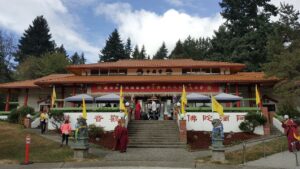 Rainbow Villa Temple in North Bend (also near Seattle), with similar preaching and lecturing. During his half-year stay in Taiwan, he would preside over a ritual at the Taiwan Lei Tsang Temple in Nantou of Taizhong, with a lecture on a chosen scripture, every Saturday afternoon. The Seattle temple [Image at right] and the Taizhong temple became the two headquarters of the school.
Rainbow Villa Temple in North Bend (also near Seattle), with similar preaching and lecturing. During his half-year stay in Taiwan, he would preside over a ritual at the Taiwan Lei Tsang Temple in Nantou of Taizhong, with a lecture on a chosen scripture, every Saturday afternoon. The Seattle temple [Image at right] and the Taizhong temple became the two headquarters of the school.
From 1989 until 1993, Shengyen embarked on a worldwide proselytizing campaign, presiding over large ritual ceremonies in different parts of the world. These efforts helped the school to develop into an international movement, although over ninety percent of the converts were Chinese. In 1993, Shengyen announced his plan to retire, but this was realized only in 2000 when he ceased his travels and teaching duties. Right before he moved into seclusion in a secret place known only to a few, Shengyen started to teach the Kālachakra (literally “wheel of time”) tantra, which is taught in all major Tibetan Schools of Buddhism including the Gelug (Yellow), Kagyu (White), Nyingma (Red) and Sakya (Flower) schools.
2006 was an eventful year for the True Buddha School, as Shengyen came out of retirement to attend the funeral of his Hong Kong teacher Thubten Dorge. He then resumed his busy schedule of traveling and ritual leadership, including several Kalachakra Empowerment rituals. In the same year, he dismissed a teaching master of the school, Rev. (unnamed individual #1), the then-Finance Director of the True Buddha Foundation (organized in 1997 to support charity work carried out by the Lotus Light Charity Society). Rev. (unnamed individual #1) was also the Chairman of the Huaguang Merit Society in California and Abbot of the Weiguang temple at Los Angeles. After his dismissal, (unnamed individual #1) changed the name of his temple to the Weiguang Chan temple and addressed himself as a Chan master . Leaving the True Buddha School with Rev. (unnamed individual #1) were some chapters of the True Buddha School closely related to him, including Dazhi in Gaoxiong, Taiwan, Haitian in Singapore, and the Yuanming and the Jintai chapters in Indonesia.
In 2016, Shengyen dismissed another teaching master, Rev. (unnamed individual #2) of the Purple Lotus Temple at Fremont, California. She changed her name after her dismissal but kept the temple’s English name. Fascinating stories were told about this event. “Demon soldiers” were said to be sent by (unnamed individual #2) to Shengyen’s home at night, only to be defeated by his spiritual protectors in a midnight war. Seventeen monks and nuns belonging to the Purple Lotus Temple were then excommunicated, together with (unnamed individual #2), by the True Buddha School.
DOCTRINES/BELIEFS
Shengyen’s teachings can be divided into two periods. In his early years, Shengyen taught about the “activation of the soul,” a Daoist folk practice to develop a devotee’s ability to communicate with the spiritual world. One is encouraged to practice quiet sitting while chanting of the name of a deity of one’s choice, adding a short petition asking the deity to help one’s activation of the soul. If one succeeds, one will experience an involuntary movement of the body, driven by an external force, causing the limbs to exercise, a phenomenon Shengyen calls the “movement of the soul.” Shengyen explains that the “activation of the soul” is the activation of inner flowing of air from the base of the spine. The flowing of air within the body causes the involuntary movement of the body and hence allows a person to have some awareness of her own “soul.” The so-called technique to “activate the soul” lies mainly on the achieving of non-arising of thoughts. The most important technique is to reduce ceaseless arising of thoughts in the mind into a single thought, and then proceed to the cessation of all thoughts.
A second stage of Shengyen’s teaching was the esoteric stage, in which he identified his teachings with the path of esoteric Buddhism. As a branch of Buddhism, esoteric Buddhism shares the same goal as Buddhism in general, i.e., to be enlightened and attain the state of Buddhahood. This is achieved by, as the Nirvana Sūtra states, “not to commit wrongs, but to do all that is good, and to keep oneʼs thought pure—this is the teaching of all the Buddhas.” These four lines are regarded as the very source of all the teachings of Buddhism. The adherents of the esoteric path believe that the esoteric path is more effective. By following the esoteric path, one can overcome affliction and deluded thoughts, progress rapidly and attain the state of Buddhahood to benefit others by focusing on ritual, visualization, and symbols. The esoteric Buddhist way to achieve the purity of thought is to fully occupy activity through the body, mouth, and mind with (1) physical signs and postures (mudrās), (2) voicing of incantations (mantras), and (3) visualization on a chosen Buddha or Bodhisattva (mandalas). Esoteric Buddhism is characterized by a personal relationship with a spirit guide or deity who leads one to enlightenment. By constantly practicing recitation of incantation of a chosen deity with the accompanying hand gestures and visualizing the image of the deity, one keeps one’s thought pure. There are eight choices of such deity in the True Buddha 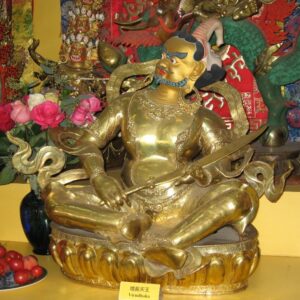 School: (1) Buddha Amitābha; (2) Bodhisattva Avalokiteśvara (Guanyin); (3) Bodhisattva Kşitigarbha (Dizang); (4) Mother of All Buddhas, Bodhisattva Cundi; (5) Padmasambhava (literally “master born from a lotus”); (6) Champara (Yellow Fortune God); Image at right] (7) Medicine Buddha ; (8) White Padmakumara (White Lotus Youth).
School: (1) Buddha Amitābha; (2) Bodhisattva Avalokiteśvara (Guanyin); (3) Bodhisattva Kşitigarbha (Dizang); (4) Mother of All Buddhas, Bodhisattva Cundi; (5) Padmasambhava (literally “master born from a lotus”); (6) Champara (Yellow Fortune God); Image at right] (7) Medicine Buddha ; (8) White Padmakumara (White Lotus Youth).
According to the esoteric Buddhist path, before one can establish a personal relationship with an invisible spirit guide or deity, one must attain a personal relationship with a human master. Through unfailing confidence and intense devotion to one’s master, one can eliminate one’s ego, the root of ignorance. Whereas there is a “Three Refuge” tradition in Buddhism, there is a “Four Refuge” tradition in esoteric Buddhism. This means that, in addition to taking refuge in the Buddha, his Dharma (teachings), and his Sangha (community), the esoteric Buddhist also takes refuge in a Guru (Shengyen, in the case of the True Buddha School). This is a complete revision of one of the most quoted principles of Buddhism: “Relying on the Dharma (teachings), not on the persons who expound it.” The esoteric path modifies this principle to “rely on both the Dharma and the persons who expound it.” The devotion to one’s master is concretely expressed as the practice of the path of Guru Yoga.
There is a common fourfold division of the esoteric path into (1) Action Tantras, also known as the “Four Preliminaries” (2) Performance Tantras, (3) Yoga Tantras, and (4) Highest yoga Tantras (Power 1995:242). In Action Tantras, the first level of esoteric practice, one engages enthusiastically in external rituals and activities, including constructing an elaborate altar to pay homage and make offerings to Buddhas and Bodhisattvas. These include prostration, supplication, and recitation. As one proceeds to Yoga Tantra, more inner cultivations are involved.
The True Buddha School adopts the same gradual approach to religious practices. The devotee starts with (1) the practice of the Four Preliminaries, followed by (2) Guru Yoga, (3) Deity Yoga, (4) the Vajra practices and finally (5) the Highest Yoga Tantra. The Four Preliminaries include taking refuge, making offerings, repentance, and recitation of the Hundred-syllable mantra of Vajrasattva. The True Buddha School places great emphasis on the recitation of the 100-Syllable mantra of Vajrasattva (a central deity of esoteric Buddhism) as a powerful purification prayer. Before one can advance to another level of practice, it is recommended that one should: complete a recitation of the 100-syllable mantra of Vaijrasattva 100,000 times, perform a full prostration 100,000 times, recite the ‘Four Refuge’ 100,000 times; and recite the sacrificial mantra 100,000 times. These four practices are collectively known as the Four Preliminaries.
To proceed to the next level of practice, which is Performance Tantra, one practices the Guru Yoga. By chanting the mantra of ones’ guru while performing his hand gesture, one endeavors to perfect one’s ability to visualize one’s guru without mental fluctuation. The goal of Guru Yoga is to develop a one-pointed concentration on one’s guru, thereby receiving an unceasing empowerment from one’s guru and becoming identified with one’s guru. When this is achieved, one can proceed to the practice of Deity Yoga, which is like Guru Yoga, except that one must choose a deity as the object of visualization. One visualizes oneself and the archetypal deity as separate beings, and then one causes the deity to enter oneself, resulting in the merging of the deity and its devotee in meditation.
In Yoga Tantra, one enters a whole new level of inner cultivation which emphasizes internal yoga or yoga without signs. In concrete terms, it involves the practice of a breathing exercise called “Capturing Air in a Precious Vase” and the “Inner Heat Yoga.”
In practicing the “Capturing Air in a Precious Vase,” one must visualize the breathing in of air from one side of the nose down to the Cinnabar Field or the “elixir field.” This is one of the three loci in the human body, located 1.3 inches below the navel, which is believed to be the seat of life-force energy in the body. While holding one’s breath, one visualizes the circulation of the incoming air inside the body, through the left and right “side channels” and the “central channel” that runs from the base of the spine to the head, and finally letting the air come out from the other side of the nose. A long period of practice of this simple exercise allows a sensation of an inner flowing of invisible energy in the form of air and an unblocking of one’s channels. This is achieved by visualization.
A similar mechanism applies to Inner Heat Yoga, in which one visualizes a source of heat present in the Cinnabar Field. This visualization is reinforced by rubbing of two hands until heat is produced. The heat is then transferred to the Cinnabar Field by hands touching the navel and further rubbing in the area between our abdomen and bladder. A long period of visualizing heat generated in the Cinnabar Field leads to an actual feeling of the rising of flame inside one’s body. Directing the “inner air” one generated in the first stage to “blow up” the flame will strengthen this feeling.
Both the flowing of “air” and “fire” inside the body generate bliss and alter the state of our consciousness, so that a different realm of reality is revealed to the devotee. This is the reality of spiritual existence, the Buddhas and their pure land. Shengyen interprets this new awareness generated by our own body as the “union between Heaven and Human being,” or a “merging with the consciousness of the universe.” He also calls it an enlightenment experience that he himself attained in 1984, one year after he arrived in America. He describes it as an experience in which time and space dissolves and there is a temporary loss of the individual self. The self becomes nothing but luminosity (Tam 2002:163ff).
One can identify three kinds of language in Shengyen’s teaching of his enlightenment experience: Indian Yoga of Kundalini, Buddhist Tantra, and Daoism. For instance, Inner Heat Yoga, one of the “Six Yogas” of the illustrious Indian Buddhist Master Naropada (b. 1016), was used by Shengyen to describe his own religious experience. The purpose of the Inner Heat Yoga is a technique of tantric meditation, which gives rise to a special tantric ecstasy. The Inner Alchemy (neidan in Chinese) of Daoism has much in common with the tantric tradition. The central idea is that enlightenment has a corporeal or somatic aspect. There is a reservoir of latent cosmic energy lying in every human being which is in a scattered and latent state. The arousal of this latent life energy, causing it to dart upwards to the top of the head will elevate the devotee to a state of spiritual ecstasy. This enlightening experience is brought about by a long persistent practice of intense mental concentration and absorption (Tam 2002:166).
One anthropologist has found that, in a sample of 488 societies in all parts of the world, 437 (or ninety percent) are reported to have one or more institutionalized, culturally patterned forms of altered states of consciousness (Bourguignon 1973:1). In the True Buddha School, this worldwide religious phenomenon is presented in the framework of cultivational discourse as a sophisticated Tantric system of four levels of practice with Inner Heat Yoga as the highest level.
Shengyen’s choice of scripture for his weekly lecture reveals another important feature of the teaching of his school, namely the harmony between esoteric Buddhism and exoteric Buddhism. From 2008-2011, he lectured on the (exoteric Chan Zen) Platform Sutra by the Sixth Patriarch. He followed with lectures on the esoteric Hevajra Tantra, which is especially popular in the Sakya and Kagyü schools until June 2013, followed by the Dzogchen (The Nine Stages of the Great Perfection) until May 2016. Next, he started lecturing on esoteric Daoguo (Lamdré or Path with the Result of Virūpa), concluding in 2021. He finished by lecturing on the exoteric Diamond sutra (Vájra-cchedikā-prajñā-pāramitā-sūtra), until May 2022. His most recent lectures have been on the famous (exoteric) Weimo sutra (Vimalakīrti Sūtra).
A unique feature of Shengyen’s teaching is his constant use of jokes in his preaching. To him, joking is not a rival to seriousness. Joke-telling in his preaching echoes the concept of “play” of John Huizinga (1872-1945). His Homo Ludens: A Study of the Play Element in Culture describes how culture is developed not only through play, but as play (Huizinga 1955). Joke-telling also echoes a teaching of Confucius. Zigong (520-446 BCE), a loyal disciple of Confucius, once told his master that he could not identify with the common folk’s carnival spirit during the agricultural sacrifice at the end of the year. Everyone seemed to be crazy, according to Zigong. Confucius, however, replied:
For their hundred days’ labour in the field, (the husbandmen) receive this one day’s enjoyment … (Even the great heroes of China) Wen and Wu could not keep a bow (in good condition), if it were always drawn and never relaxed; nor did they leave it always relaxed and never drawn. To keep it now strung and now unstrung was the way of Wen and Wu. (Analects Zaji II).
The principle of alternating “drawn” and “relaxed is fully in play in Shengyen’s preaching, as he fills his “serious talks” with endless “jokes.”
RITUALS/PRACTICES
The True Buddha School is particularly rich in ritual. Using the True Buddha School temple in Hong Kong in 2023 as an example, the following rituals are common to the True Buddha School temples around the world: Rituals related to Chinese New Year [Installing the Year Planetary Ruler according to Daoist Astrology (February), Blessing the tablets/lamps honouring a living benefactor (February), Burning the first incense of the year (February), Celebrating the Chinese New Year (February)]; Deliverance of the souls of the dead during Qingming Festival (April); Deliverance of the souls the dead during the Yulanpen (Ghost festival in July); Celebrating the birthdays of Buddhas, Sakaymuni (May); Bhaiṣajyaguru (Medicine Buddha, November); Celebrating the birthdays of Bodhisattvas [Manjusri (May), Cundī (April), Uṣṇīṣavijayā (March), Guanyin (March)]; Commemorating leaving the household of Grand Grandmaster Lu (February); Celebrating the birthday of Grandmaster Lu (July).
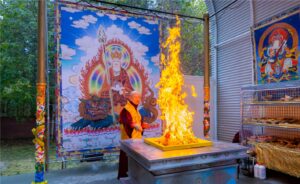
One of the most intriguing features of the True Buddha School’s ritual is, no doubt, its fire-ritual offering, in which all offerings are literally burnt in a fire. [Image at right] There are four kinds of fire-ritual offering: i) Purification, ii) Magnetization, iii) Enrichment, and iv) Subjugation. Depending on the purpose of a specific fire offering, the form and colour of the altar and the offerings to be made will differ. Nevertheless, the overall structure of the performance is the same, in three main parts: (1) Prologue: preparatory practice (2) Main Body: practice (3) Epilogue: concluding practice.
The True Buddha School embraces paranormal or supernatural and magical elements in religious practice. Shengyen himself reported a dramatic clairvoyant experience and extra-sensory perceptions, the ability for which was bestowed on him from the spirit world. He was taught by invisible teachers and possesses miraculous powers. Miracles and miraculous responses are perennial themes of his many books. Extra-sensory perceptions and miraculous power, Shengyen claims, can be obtained through training or self-cultivation. One of the most recurring concepts of the True Buddha School practices is the concept of response (ganying in Chinese). Every single disciple of the school has his or her story of response, mostly consisting of a healing miracle or a story of having contacts with the spiritual world. In the True Buddha School Weekly, a column is devoted to a story of response in every issue. Shengyen’s preaching usually begins with the self-reporting of his response (his perception of how Buddhas and Bodhisattvas descended during the ritual to receive the offerings and bestowed their blessings). These spiritual blessings could bring about worldly attainment, which is used as a skillful or expedient means (upāya) to attract followers, and re-direct them to the practice and wisdom of the Buddha. Magical responses tend to be reported more often by new followers. For converted devotees, they must be earned through faithful continual daily practice, which Shengyen prescribes for an hour per day for laymen and laywomen, and four hours per day for monks and nuns. The daily practice of the school follows the same tripartite structure of Prologue, Main Body/Practice, and Epilogue outlined above. It consists of the same tripartite tantric elements: mantra, mudra, and visualization. The efficacy of each practice depends on the visualization power of a practitioner, i.e., the ability to visualize a deity and merge with him or her (Tam 2001:162-63). The response of practice for converted devotees may no longer be a worldly attainment. It could be the vibration of the body as in the case of activation of the soul or circulation of inner heat and air in the body as in the case of inner heat yoga. Activation of the soul is related to the communication with the spiritual world and inner heat yoga is the key to enlightenment which is the goal of Buddhism.
ORGANIZATION/LEADERSHIP
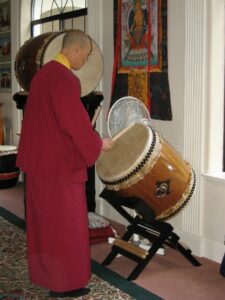
Members of the True Buddha School can be broadly divided into two groups: the missionaries and the laymen and laywomen. In early years of the True Buddha School, missionaries only consist of Acharya, addressed as master, and monks or nuns, addressed as Reverend (or Fashi in Chinese). Later, three more categories were added to make up five ranks of the True Buddha School missionaries with Shengyen (Grandmaster Lu) as the Root Guru at the top. They are:(1)Acharya (Shangshi in Chinese, clothed in Lama uniform with a yellow collar); [Image at right](2)Senior Reverend (Jiaoshou shi in Chinese, Lama uniform with a green collar);(3)Reverend (Fashi in Chinese, Lama uniform with a red collar);(4)Dharma Instructor (Jiangshi in Chinese, Lama uniform with a blue collar)(5)Dharma Assistant (Zhujiao in Chinese, Lama uniform with a white collar).
Missionaries are selected from core members of a temple or chapter of the school and are recommended to Shengyen for formal conferment. In recent years, a training and assessment by Shengyen himself has been added to the process. On September 6, 2009, Shengyen announced that all those who want to become an Acharya in the True Buddha School must first leave their households, that is to become monk or nun. The same requirement applies to the rank of Senior Reverend.
From the “letter reply centre” in Seattle, maintained by Shengyen and his close disciples, charms of all kinds are also sent out to those who request them. The days before and after the annual conventions are also occasions for disciples to meet Shengyen for blessing and or divination-consultation sessions. From April 11, 2020, onwards, added an interaction section before every sermon of his. Pre-selected questions from disciples will be answered. This increases substantially the chance of interaction with his disciple, which plays an important role in nurturing the charisma of Shengyen as Grandmaster Lu and the leader of the school. Barker has labelled this process of personal and group socialization “charismatization” (Barker 1993:181-201).
A Central Committee for the School’s Affairs was set up after Shengyen’s retirement in 2000 to assume group leadership of the school. The committee was elected from among the Acharyas of the school, now numbering over 130. Each local temple and chapter of the school enjoys a high degree of autonomy, especially in financial matters, from the school’s headquarters in Seattle or in Taizhong. The Central Committee sets only general guidelines in religious and administrative matters for all local temples and chapters. The Central Committee, though, may excommunicate individuals and criticize behaviour violating guidelines set by the committee by issuing warning letters through the official newspaper, the True Buddha School Weekly (Zhenfo bao).
ISSUES/CHALLENGES
Melton has noted that “as the True Buddha School has assumed a role in Taiwan, Hong Kong, and throughout southeast Asia as a significant competing organization to the larger Pure Land and Chan organizations, Shengyen has increasingly become an object of controversy” (Melton 2007:298). Mainstream Buddhist schools tend to use the label of “new religion” to describe the True Buddha School. Labelling a group as a “new religion” could be used as a strategy by dominant religious groups to marginalize a more recent group and take away the right of the recent group to claim to be part of an established religion (Tam 2007:303-16). In order not to privilege unfairly the older and better-established religious groups and discriminate against smaller, less well-known groups, Durham proposed that an organization should be entitled to “religious freedom protection” unless and until they operate to injure or threaten the concrete rights and interests of the state (Durham and Sewell 2006:85). These rights and interests include the protection of public health, safety order, morals, and the fundamental rights and freedoms of others. They become significant only when there are immediate and concrete concerns, not just when abstract, speculative, and remote worries are voiced. Unless state interests are compromised, we should defer as much as possible to a group’s own claims as to whether they belong to an old tradition or a new religion. Otherwise, we will be in danger of falling into the trap of siding with the dominant organizations in marginalizing a more recent group.
The True Buddha School is, thus, best seen as a distinct new sect of Buddhism that is becoming an increasingly important element of the Vajrayana community, laying out an innovative path within the older Vajrayana Tantric Buddhist community as represented by Tibetan, Mongolian, and Japanese Shingon Buddhism. It is this new path being developed by the True Buddha School, more than any other feature, which has made it and its leader an interesting object of study.
The True Buddha School in the West manifests as an ethnic-based religion, serving primarily Chinese diaspora communities in North America and Europe. In Southeast Asia, it has been the subject of a variety of theological controversies, especially in Taiwan and Malaysia, while in the West, where Buddhism is itself a distinct minority, it had developed largely without significant controversy as simply another branch of the Buddhism at large. It also emerges as one of the interesting movements to assume a place on the Western religious landscape. A study of the school may well help us to recognize the importance of the immigrant Buddhist communities in the reshaping of Western Buddhism and the developing vision of Western Buddhist life.
IMAGES
Image #1: Founder of the True Buddha School, LU Shengyen.
Image #2: A portrait of the ‘White Lotus Youth’ of the True Buddha School (image provided by the Taizhong Temple of the school https://tbsec.org/).
Image #3: Daoist teacher of the founder, Master Qingzhen.
Image #4: A portrait of the pantheon in the True Buddha School (picture provided by Master Tige from Vancouver).
Image #5: The Seattle Temple of the True Buddha School (Image provided by Master Tige from Vancouver).
Image #6: Champara (Yellow Fortune God, a manifestation of the Vaiśravaṇa, one of the Four Heavenly Kings).
Image #7: Fire ritual in Seattle on 30 October 2022. (Image provided by True Buddha School Net https://ch.tbsn.org/home/index )
Image #8: Acharya (Shangshi), clothed in Lama uniform with a yellow collar.
REFFERENCES
Barker, Eileen. 1993. “Charismatization: The Social Production of ‘an Ethos Propitious to the Mobilization of Sentiments’. ” Pp. 181-201 in Secularization, Rationalization, and Sectarianism: Essays in Honor of Bryan R. Wilson, edited by Eileen Barker, James A Beckford and Karel Dobbelaere. Oxford: Clarendon Press.
Bourguignon, Erika. 1973. “Introduction: A Framework for the Comparative Study of Altered States of Consciousness.” Pp. 1ff in Religion, Altered States of consciousness and Social Chang, edited by Erika Bourguignon. Columbus: Ohio State University Press, p.1ff.
Durham, W. Cole. Jr. and Elizabeth A. Sewell. 2006. “Definition of Religion.” Pp. 1-84 in Religious Organizations in the United States: A Study of Identity, Liberty, and the Law, edited by James A. Serritella et al. North Carolina: Carolina Academic Press.
Huizinga, Johan. 1955. Homo Ludens: A Study of the Play-Element in Culture. Boston: Beacon Press.
Melton, Gordon. 2007. “The Affirmation of Charismatic Authority: The Case of the True Buddha School.” Australian Study of the Play element in Culture. Religion Studies Review (now the Journal for the Academic Study of Religion) 20:286-302.
Powers, John. 1995. Introduction to Tibetan Buddhism. New York: Snow Lion Publications.
Tam, Wai Lun 2016. “The Tantric Teachings and Rituals of the True Buddha School: The Chinese Transformation of Vajrayāna Buddhism.” Pp. 308-36 in Tantric Traditions in Transmission and Translation, edited by David B. Gray and Ryan Richard Overbey. New York: Oxford University Press.
Tam, Wai Lun. 2007. “Re-examining the True Buddha School: A ‘New Religion’ or a New ‘Buddhist Movement’? Australian Religion Studies Review (subsequently the Journal for the Academic Study of Religion) 20:303-16.
Tam, Wai Lun. 2002. “Enlightenment as Hope according to the True Buddha School.” Pp. 155-79 in Interpretations of Hope in Chinese Religions and Christianity, edited by Daniel L. Overmyer and Chi-Tim Lai. Hong Kong: Christian Study Centre on Chinese Religion and Culture.
Tam, Wai Lun 2001. “Integration of the Magical and Cultivational Discourses: A Study on a New Religious Movement Called the True Buddha School.” Monumenta Serica 49:141-69.
Teiser Stephen F. and Verellen Franciscus. 2011. “Buddhism, Daoism, and Chinese Religion.” Cahiers d’Extrême-Asie 20:1-12).
Publication Date:
12 March 2024
